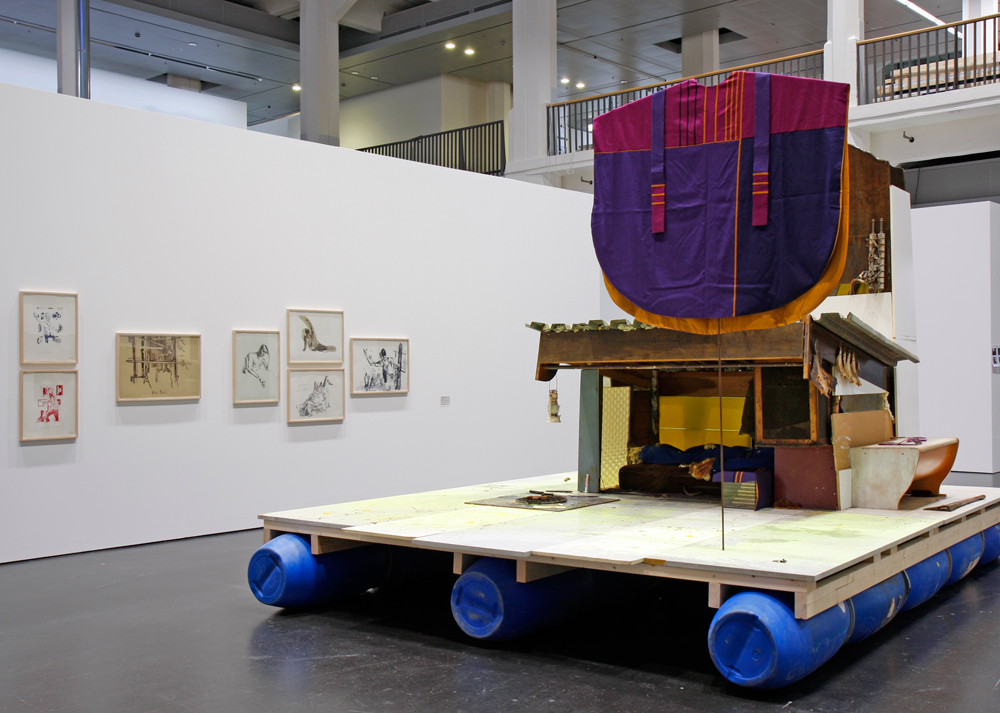Paul Thek
ZKM / Museum für Neue Kunst, Karlsruhe, Germany
ZKM / Museum für Neue Kunst, Karlsruhe, Germany

Bringing together over 300 works by Paul Thek, this large retrospective sought to shed further light on the late artist’s oeuvre by placing it within a thicket of more recent works by 25 contemporary artists. ‘Paul Thek in the Context of Today’s Contemporary Art’ opened with a billboard-size lightbox photograph of Thek from 1969, one year after his first encounter with the shamanistic work of Joseph Beuys. Thek, who died in 1988 at the age of 54, is depicted wearing shades and in private communion with what appear to be the belongings of an eccentric loner: the severed wing of a buzzard and an industrial plastic sink wrapped around a tree.
Following the exhibition of his ‘Meat Pieces’ (1964–6) – wax renditions of stringy pieces of flesh – Thek was already known in art circles by the mid-1960s as the ‘meat man’. But in 1967, at the age of 33, he was catapulted to greater fame when he exhibited his first ‘environment’, a pink-painted pyramid called The Tomb. Like a Kabbalistic flying tower, this work truly took flight, being shown in renowned exhibitions throughout Europe until the infamous wax protagonist laid to rest in this pink ziggurat – an effigy of Thek himself – was so irreparably damaged in a crate shipped from Rotterdam in 1981 that Thek refused to accept it at customs.
Edwin Klein’s photographic documentation of The Tomb renders what was once a bright pink environment into a black and white installation. Inadvertently, a parallax is created between Thek’s oeuvre and the now-legendary situations out of which his works evolved: on the one hand, we have the flashy Froot-Loops spectrum – seen, for example, in the brightly coloured Perspex used to encase some of the ‘Meat Pieces’ (renamed ‘Technological Reliquaries’ in 1977) – and on the other, we have the photographic documentation of the environments in muted greys.
Likewise, we can only guess at the earthy tones of Thek’s ‘Processions’ (1971–9) – environments-in-progress even after being put on display – since the curatorial team of Roland Groenenboom, Gregor Jansen and Harald Falckenberg (the exhibition will tour to the Falckenberg Collection, Hamburg, in May) relied heavily on life-size photographs. Placed in front of an image of The Tomb was a vitrine containing the remaining relics of the work: three fingers of the wax effigy – excluded from the original piece – are displayed alongside a hand that formed part of the initial sculpture but was later severed, in an odd constellation that also includes Untitled (Dental Plate) (1967) and Untitled (Penis Cast in Resin) (1964). The resultant Madame Tussauds effect does little but encourage the kind of idolatry that was anathema to the ceremonial atmosphere of Thek’s original environment.
Nearby, in Untitled, Self-Portrait (1966–7), the artist’s faux death mask protrudes from the top of a ziggurat form and, as though in a moment of last-minute glee, he sticks out his pierced tongue. An arm, placed adjacent (Untitled, 1966), conjures up the occult: dipped in silver and dusted with long sandy hairs that seem placed there almost as an afterthought, the limb appears to be embellished with a phylactery (a Jewish prayer box), whose leather bands, pink plastic rings and nebulous amulets stoke an illusion of some mysterious, eternal ritual.
While the abundance of original works on display was great, less convincing is the decision to place remnants in vitrines – amongst Thek’s own vitrines. Indeed, the encyclopaedic gimmickry reached its apex in a lonely latex fish, the single vestige of Fishman (1968); a work that originally included, amongst many other elements, a latex cast of the artist.
Despite the impermanence of Thek’s environments, the artist’s Pied Piper-like influence on current art production can be felt in contemporary works such as Sebastian Hammwöhner, Dani Jakob and Gabriel Vormstein’s I Cannot Forward, or Rewind This State of Being, This Aged Resign: Let the Wind Catch a Rainbow on Fire … (2004). This eccentric tabletop collection of objects – including a bronze honeycomb bisected by a mirror and a child’s galoshes graced with bells – bears the signature of what seems to be the collective mind of an uncharted civilization. Kai Althoff and Robert Elfgen’s Das Floss (The Raft, 2004), with its makeshift hut on a life-size raft, seemed to be broadcasting from the same evangelical channel as Thek’s Noah’s Raft, which he built with the help of street children at the Sao Paulo Biennial in 1985. Many other works – Gregor Schneider’s Hannelore Reuen (2004), a middle-aged lady who has fallen flat on her face in her tights (but missing pants), or the grotesque mannequins of Thomas Hirschhorn’s Outgrowth Family (2006) – were linked, however, only by formal affinities. Which is ironic, given that Thek’s work was less about a succession of similarities than a secession from the compos mentis.
























